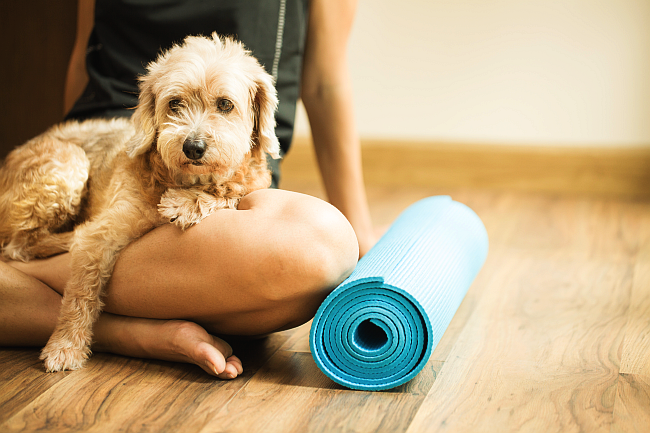
Mimicking the human practice of yoga has become an increasingly popular for pets. So much so, in fact that it is officially referred to as “doga.” There are books on pet yoga, videos you can watch online, and classes to attend in person. But does any of this really make sense? Does it benefit the dog in an effective or beneficial way, or is this nothing more than a frivolous fad intended on duping people into spending their extra money on a worthless trend? Here are some of the details of what pet yoga classes entail and whether or not they are worth your time.
The Low-Down on “Doga”
Yoga has been known to benefit human bodies through stretching, breathing, meditation, and strengthening by holding difficult poses. The practice is a fundamental part of Hindu philosophy, but used in western culture as a stabilizing exercise of the mind, body and spirit. There are several branches of yoga, including hatha yoga (breathing, flexibility), vinyasa (power strengthening yoga), iyengar (using blocks and weights) bikram (hot climate yoga), kundalini (spiritual meditation), and ashtanga (long, challenging sessions for experienced yogis).
In doga classes, there is usually a combination of many yoga forms. The dog will accompany his human to the yoga class where the two will partner together to form poses, stretch, meditate peacefully, and offer support to each other in the session. The human will help the dog gently stretch his body in new ways and try to form classic yoga poses such as “greeting the sun” and attempt a real-life rendition of “downward facing dog.”
In the course of the hour, the dogs share a limited space with numerous new humans and their pets just one yoga mat away. This tends to massively overstimulate the dog, creating great excitement which usually breaks the “zen” relaxing ambience. Many pet owners have reported that bringing a fair amount of treats with them was about the only way to help pups maintain focus and obedience during the session. While the yoga instructor exhibits the next pose with a stuffed animal dog, to illustrate what people should do with their live dogs, people with larger animals often have a tough time getting their pups to be as compliant. The dogs in the class are never forced into any position, nor made to sit in any uncomfortable or unnatural pose. One review writer claimed her experience was a waste of time, noting that her Grey Hound only wanted to lie next to her mat, scarfing as many treats as he could while his owner did the stretches solo.
Others mentioned the hilarity of watching other dog owners and their pets struggle to achieve poses, and looking ridiculous in the process. This often causes classmates to giggle at the comedic scene of dogs barking, rolling around, posing backward, or just doing their own thing in the middle of class. The laughing is not looked down upon, but rather encouraged as laughter is believed to spiritually strengthen the unity and bond both between people and their pets, and well as with their fellow yogis in the room.
Are there any benefits?
Working with the dog in this kind of class is thought to do both the pet and their human physical and emotional good. Pet yoga instructors insist that the overall practice improves a pet’s blood flow, balance, flexibility and harmony. Additionally it is a good bonding opportunity for the dog owner to come home in the evening, and instead of racing off to the gym, or walking on the same old path, they get to reinvent a way to connect with their dog. The pup will see it as a social hour where he gets some hands-on attention, play time and fun with his owner. There are also treats involved, and massages and stretches which loosen stiff joints and soothe their ailments.
Though there are no end of scoffers when it comes to the concept of “doga,” the most balanced way to regard this practice is to accept that your dog does not need to do this kind of exercise. But your dog DOES need daily time with you. Therefore, combing a lighthearted and gently beneficial form of exercise certainly will provide a positive way for you and your pet to interact.
Resources:
http://www.animalplanet.com/video-topics/pet-care/dog-training-videos/dog-yoga/
http://thebark.com/content/doga-yoga-you-and-your-dog
http://www.nytimes.com/2009/04/09/fashion/09fitness.html?_r=0

